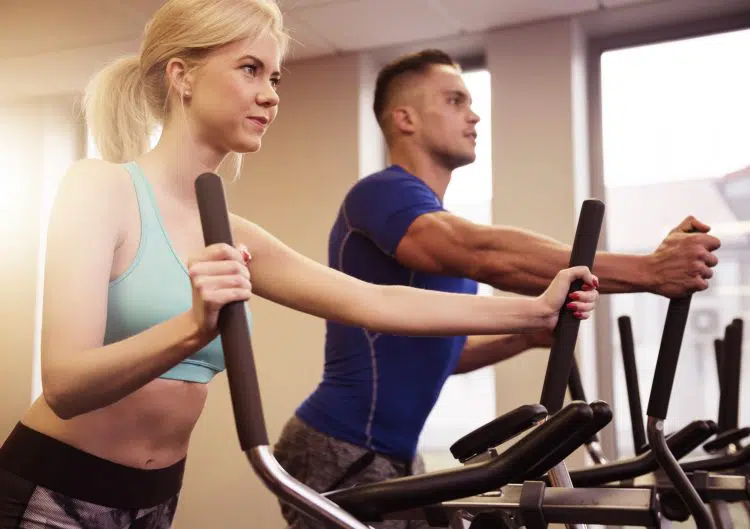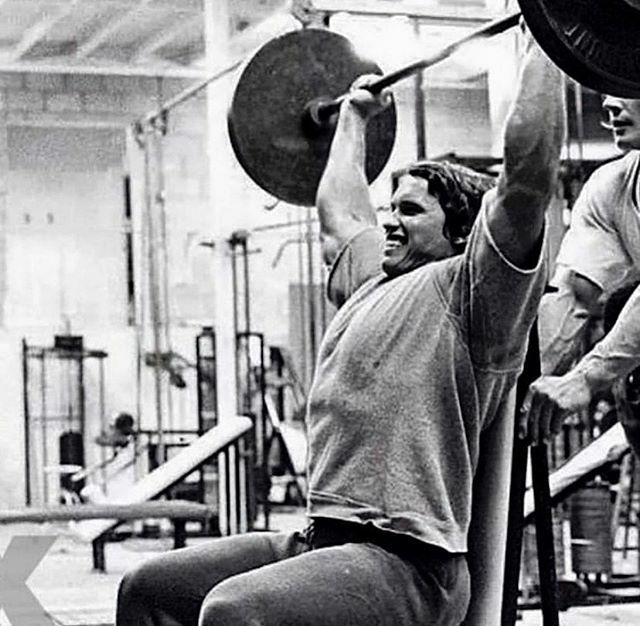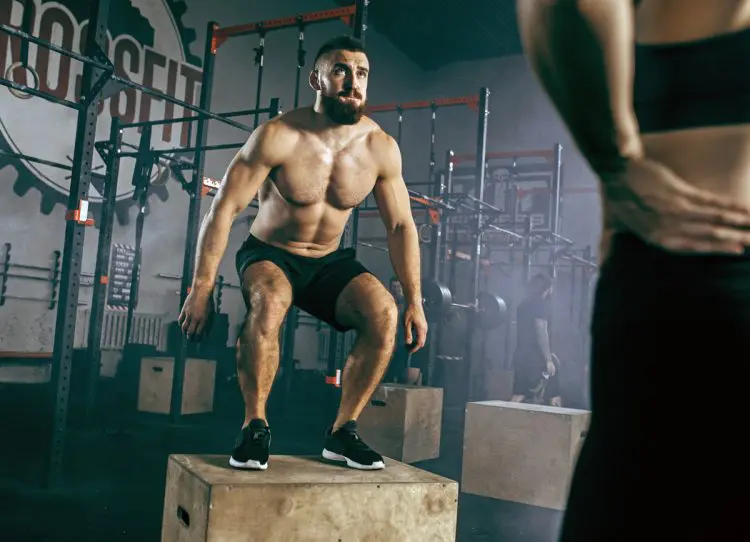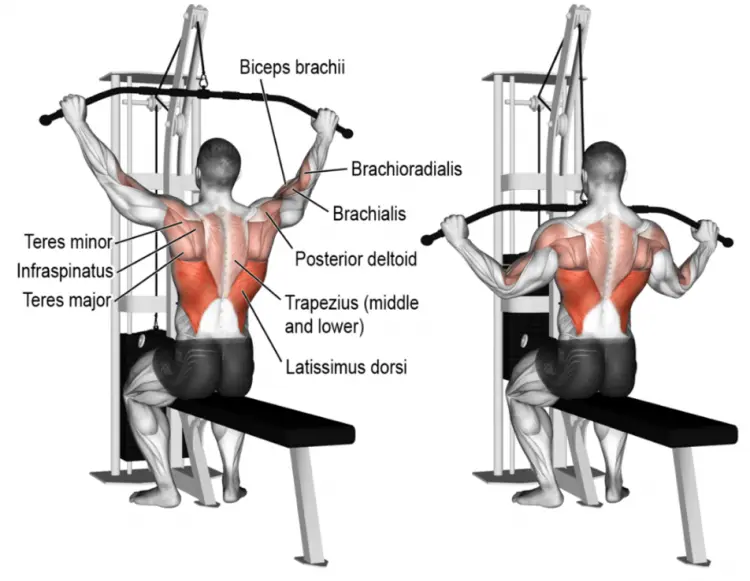If you want to build bigger, stronger muscles, you need to lift weights. It doesn’t matter if those weights are dumbbells, barbells, kettlebells, machines, or your own body. It’s only by overloading your muscles that they’ll get bigger and stronger.
Conversely, cardio is the best way to get fit and burn fat. Activities like rowing, cycling, running, or using an elliptical burn calories and fat while challenging your heart and lungs. You can choose between low-intensity steady state (LISS) or high-intensity interval training (HIIT) cardio, but the end result is the same: fitness and fat burning.
But what if you want both these things – muscle and fitness?
If that’s the case, you’ll probably do cardio one day and strength training the next. And while this two-pronged approach clearly works, it can also be time-consuming.
You’ll need to commit to at least four workouts per week (two strength, two cardio) and may even end up doing six or more. Or, you could do cardio and strength training in the same workout, but that means hitting the gym for up to two hours at a time.
Level Up Your Fitness: Join our 💪 strong community in Fitness Volt Newsletter. Get daily inspiration, expert-backed workouts, nutrition tips, the latest in strength sports, and the support you need to reach your goals. Subscribe for free!
However, there is an alternative, and it’s called PHA training.
PHA training bridges the gap between strength training and cardio and provides one of the best “bang for your buck” workouts around. After your warm-up, a PHA workout should take about 30-40 minutes, hitting all your major muscles groups in the process. This makes it a very time-efficient form of training.
So, short of time? Want to improve your cardiovascular fitness and muscular fitness simultaneously? Need to burn lots of calories? Want to preserve or even build muscle while getting lean?
PHA could be exactly what you are looking for.
In this article, we reveal the science behind PHA, explain how to create your own PHA workouts, and provide you with a couple of sample programs to try.
What is PHA Training, and How Does it Work?
PHA is short for Peripheral Heart Action. But that’s hardly a snappy name for a workout, so we’ll stick with PHA!
PHA training is a variation of circuit training. However, unlike circuit training workouts, the exercises in PHA are done in a very prescriptive order. It’s that order that makes PHA such an effective workout.
When you train, oxygen-carrying blood is preferentially diverted to the working muscles. Getting your blood to those working muscles involves an increase in output from your cardiovascular or CV system, specifically, your heart and lungs.
If, as with PHA training, you then perform an exercise for a different muscle group, oxygenated blood has to be “shunted” to this new area of the body. The CV system again bears the brunt of this extra workload.
So, for example, if you do a set of squats and then a set of push-ups, your cardiovascular system must drive blood to your legs and then back up to your upper body. This involves a lot of work!
By strategically selecting muscle groups that are anatomically far apart (or peripheral) from each other, the heart and lungs must work harder than usual even though no actual cardiovascular exercise is being performed. It’s cardio by default.
The result is a cardio workout performed with weights, giving you twice the bang for your workout buck.
To get the most from a PHA workout, you must place your exercises in the correct order. To help you with this and to provide you with the means to design your own PHA workouts, there is a simple template below for you to follow.
Exercise order template
| No. | Exercise Type | Example Exercise |
| 1 | Compound leg | Lunge |
| 2 | Vertical push | Barbell shoulder press |
| 3 | Vertical pull | Lat pulldown |
| 4 | Compound leg | Step up |
| 5 | Horizontal push | Chest press |
| 6 | Horizontal pull | Seated cable row |
Choose compound rather than isolation exercises, as the more muscles you can recruit at the same time, the greater your heart rate response will be. For example, lunges will drive your heart rate up higher than leg extensions.
Perform each exercise for 12 to 20 reps. While fewer repetitions can work, that will be less effective for driving your heart rate up to a suitably high level. Moderate to high repetitions also result in a more significant rise in lactic acid levels, producing an even higher heart and breathing rate response.
You have probably noticed that the template above does not include any direct core or arm isolation exercises. That’s because, as useful and important as exercises like triceps pushdowns and planks undeniably are, they have a minimal impact on your cardiovascular system.
To avoid diluting your PHA workout with low-intensity exercises, it’s usually best to do a few sets of arms and abs once you have completed your main workout. Also, remember that your arms and abs are involved in many of your main exercises, albeit indirectly.
Level Up Your Fitness: Join our 💪 strong community in Fitness Volt Newsletter. Get daily inspiration, expert-backed workouts, nutrition tips, the latest in strength sports, and the support you need to reach your goals. Subscribe for free!
That said, we understand how some exercisers love to train their arms and abs separately. So, we’ve created a couple of bolt-on workouts you can do after your PHA workout. Check out the example programs below for more details.
More on Exercise Selection
You could perform a PHA workout using exercises like machine seated chest presses, seated shoulder presses, and other exercises where backrests provide an element of support.
In fact, if you are a relative newcomer to strength training, that might even be a good idea.
Machine-based exercises provide support while guiding the weights, which may be helpful if you find that the residual fatigue generated during a PHA workout leaves you rocking and rolling about like a drunken pirate on the high seas!
If, however, you are an experienced exerciser and are pretty stable when performing exercises even when fatigued, you can make your PHA workouts more demanding by using predominately free weights. And, if you really want to crank things up, consider performing all of your exercises in the standing position.
This means that you’ll activate even more muscles which will drive your heart rate up higher still.
While effective, this free-weight only/standing approach is not for the faint-hearted, even if you are an experienced exerciser. So, it may be helpful to include a couple of more straightforward exercises in your PHA workout so that you don’t fatigue too quickly.
Finally, avoid putting overlapping exercises close together. For example, deadlifts and bent-over rows are very different movements, but both strongly involve your lower back. It would be better to separate these exercises, so one won’t adversely affect your performance of the other.
Sample PHA Workouts
You’ve now got all the information you need to write your own PHA workouts. Just use the template above and slot in your preferred exercises. Use more machines than free-weights if you are new to this kind of training, or more free-weights and standing exercisers if you are already pretty fit and strong.
But, to save you the bother, here are two PHA workouts to try – one for intermediate exercisers and one that’s more advanced.
Perform your choice of workout three times a week on non-consecutive days, e.g., Monday, Wednesday, and Friday, for the next six to eight weeks.
Strive to increase your weights or reps on a week-by-week basis and always precede your workout with a thorough warm-up consisting of 5-10 minutes of easy cardio and dynamic mobility and flexibility exercises.
Finish your workout with a few more minutes of easy cardio followed by some static stretches for your major muscle groups.
Workout One – Intermediate PHA Programme
| No: | Exercise |
| 1 | Leg press machine |
| 2 | Seated dumbbell overhead press |
| 3 | Lat pulldown |
| 4 | Alternating lunge |
| 5 | Barbell bench press |
| 6 | Chest supported incline row |
| 7 | Elliptical – 3 to 5 minutes* |
| Do three to five laps of 12 to 20 repetitions per exercise. Take no rest between movements but 60 to 120 seconds between laps.
*Cardio “blast” optional |
|
Workout Two – Advanced PHA Program
| No: | Exercise |
| 1 | Barbell front squat |
| 2 | Standing barbell overhead press |
| 3 | Pull-up/chin-up* |
| 4 | Kettlebell swing |
| 5 | Incline plyo push-up* |
| 6 | Sumo deadlift high pull |
| 7 | Air bike – 3 to 5 minutes |
| Do four to six laps of 12 to 20 repetitions per exercise. Take no rest between movements but 45 to 90 seconds between laps.
*Rep out to failure |
|
Abs and Arms Bolt-On
While PHA workouts are already very complete, some exercisers still want to do additional training for their abs and arms. So, for those people, here are a couple of short-but-sweet abs and arms “bolt-ons” to do after you’ve completed your main PHA workout.
To save time, these workouts follow a similar layout to the main PHA programs above. However, they probably won’t have much of an impact on your cardiovascular system.
Please note that these bolt-ons are supplementary to and not a replacement for your main PHA workout. Nor are they essential because your abs and arms have already been trained, albeit indirectly. So, it’s up to you if you do them or skip them entirely.
Abs and Arms Workout One
| No: | Exercise |
| 1 | EZ bar biceps curl |
| 2 | Rollout |
| 3 | EZ bar skull crusher |
| 4 | Cable crunch |
| 5 | Concentration curl |
| 6 | Butt-up |
| 7 | Triceps pushdown |
| Do two to four laps of 12 to 20 repetitions per exercise. Take no rest between movements but 60 to 90 seconds between laps. | |
Abs and Arms Workout Two
| No: | Exercise |
| 1 | Hammer curl |
| 2 | Saxon side bend |
| 3 | Triceps dip* |
| 4 | Serratus crunches |
| 5 | Cable curl |
| 6 | Knee tucks |
| 7 | Diamond push-up* |
| Do two to four laps of 12 to 20 repetitions per exercise. Take no rest between movements but 60 to 90 seconds between laps.
*Rep out to failure |
|
PHA Training – Wrapping Up
Peripheral Heart Action (PHA) training is the ideal workout for anyone who doesn’t want to do strength training and cardio separately. By doing the exercises in your program in such a prescriptive way, you can develop cardiovascular fitness and muscular strength/size simultaneously.
PHA is also a very effective fat loss workout.
That said, if you want to maximize hypertrophy or strength or train to run a marathon or for other endurance sports, PHA may not be the workout for you.
But, for general exercisers, this type of training could help you achieve all your fitness goals at the same time.













